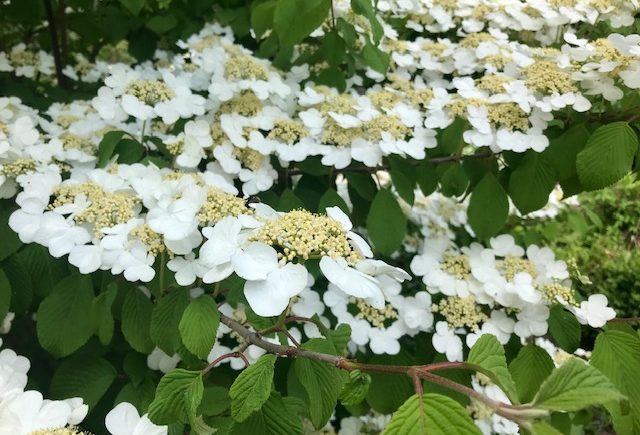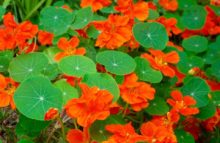At a recent Toronto Botanical Gardens talk, Sean James gave us the lowdown on how he uses shrubs. Sean, who’s been gardening since he was four, is an entertaining speaker with tons of knowledge. Sean graduated from Niagara Park school and he now runs Sean James Consulting and Design. He’s an award-winning environmentalist, who is passionate about biodiversity, while having a garden which he describes as “English cottage on steroids”
The first thing he showed us was an info sheet and a diagram on an approved new way of tree planting, dispelling much outdated ‘conventional wisdom’. Together with Landscape Ontario, they’ve pinpointed the best science to make “a tree planting as good as it can possibly be”. You get the scoop here, and the diagram will be uploaded to Landscape Ontario soon.
- Recommended are biodegradable ties, placed low on the tree—the tree should be able to move around in the breeze.
- Any ties should be left on a tree for no more than a year.
- Plant the tree in the soil it’s going to be growing in, without ground amendments.
- Place any amendments on the soil surface, and let it compost downwards, with the help of soil microbes and worms.
- Another tip: scratch out the top surface of soil in the pot when buying a single-stem tree or shrub. You need to look for the crown of the tree, and place that at the surface. Burying trees and shrubs too deep is one of the worst things that you can do
Sean got involved with creating this new tree planting info sheet, because, he says, “There’s a whole honking lot of misinformation out there.”
After focussing on perennials at the beginning of his gardening career he soon learned that shrubs make the garden stronger. Sean says flowers come and go, but texture makes the garden.
Sean’s Shrub Picks for Spring
Species Eastern red bud
Flowers early and is great for early pollinators. You can actually eat the flowers, but only the flowers. Everything else in the red bud is poisonous. ( by the way, wisteria and black locust flowers are edible as well.)
The Eastern red bud is valuable because it’s an understory plant, so you can plant it underneath trees. It grows under the tree canopy, so can take some shade, but also grows well in sun.
Snowmound spirea
Sean likes to sing the praises of shrubs that at one time have been over planted and to rethink them, believing that many of these overlooked shrubs are underrated.
Purple leaf sand cherry, prunus sistena
Another underrated plant, Sean talked about how scented the pink flowers are in spring. He told us about one such shrub planted in front of the house, that also had a door painted pink; it made an amazing picture in the spring. He reminded us to always look at the wall, or backdrop the shrub is going on. It sets the stage for your plant.
Another fragrant plant plant Sean likes is lonicera fragrantissima, winter honeysuckle. It has a lemon vanilla fragrance.
Soil and shrubs
Sean’s main advice is don’t fight the soil. Pick a plant that matches the soil. (Although he admits he has a “rescue-dendron Garden”, from discarded rhodos from his design projects. He amends this garden with peat moss.)
Sean says there’s no bad soil, but if you want to improve any soil just place any amendments on top and wait for the worms to pull it down into the depths. He’s a believer in not disturbing the soil, which is the new thinking on soil, with the “No Dig” movement.
Pruning
Sean’s general advice is don’t fight the shape of the plant. Think of pruning as guiding rather than forcing. If a shrub has a fountain shape try to let that natural growth habit be sustained.
However, in practical situations, he recommends what he calls goal-oriented pruning. For example, has espaliered the serviceberry on the fence line between his and his neighbours house. Anything that pokes out he cuts back and anything that grows sideways he encourages.
Hedges
Sean says avoid alpine currant. It’s a host to the white pine blister rust. Plant instead clove currant. It’s scented when in bloom. It prefers sun but will still perform at about 50% in dappled shade.
Shrubs for summer
Rubrus odoratus, Flowering Raspberry.
It will grow under maples in dry shade, blooming with pink flowers in late May.
Button bush, cephalanthus
Bees love the spherical white flowers, and the leaves turn yellow in fall. It’s also good for rain gardens. (Rain gardens are those that can cope with large influxes of water, as well as dry spells)
Potentilla, dasiphora fruticosa
For sunny areas, and wet or dry soil. It can be an effective rain garden plant and it is native to Ontario.
Sean says avoid double flowers as they are less attractive to bees. They can’t get inside to get the nectar. (This is same for any flower, avoid doubles if you want to host pollinators.)
Hibiscus perennial, Moscheutos
This is a shrub size perennial which is a nativar. Late summer blooming, with gigantic flowers. Attracts hummingbirds and butterflies. Sean says there is a brand new blue variety which is really great.
Dwarf lilac, syringa meyeri
For someone who wants a lilac but doesn’t have a room for the large regular ones, dwarf varieties are a good idea. “Don’t kid yourself though” he says “they do get quite large.” ‘Palabin’ may be a good choice for a small garden, (grows up to 5 ft) and the fragrance is a knockout in June. A cluster of 3 of these will knock your socks off with fragrance.
For any fragrant shrub, Sean says remember to plant up-wind so that the fragrance will waft towards you. Our prevailing wind is west north west.
Samucus nigra Black Lace Elderberry ‘Eva’
In general, you should prune branches right to the swell at the join. But Sean purposely breaks the rules here by leaving some nubs on his sambucus, as native bees make will homes in the hollow stems.
Sean says, “Remember you are not just a gardener, you are helping to maintain biodiversity. “ Sean was one of the writers of the Grow Me Instead pamphlet put out by the Ontario Invasive Society. The number one factor affecting bio diversity is the growth of invasive species.
Another sambucus is ‘Lemony Lace’, a fave of Seans.
Weigela Florida
We’re living at a lucky time as horticulturalists because there are so many new colours, sizes and shapes of this plant. And Sean says “it is bulletproof”. Weigela will grow in shade but it will be less dense more “fountainy” and with fewer leaves and flowers—but it will grow. Sean says “plants are more broadly tolerant than we give them credit for.”
Sean’s Shrub Picks for Fall
Sean’s main tip is to choose your shrubs at the nursery in the fall, so you can see the actual colour it will have. Individual plants can vary.
Hamamelis virginia, Autumn Witchhazel
Pollinated with owlet moth. They “unbloom” on cold days. Their flower heads look like little fingers that open and close. It’s an understory tree, so can take shade.
Viburnum alnifolium, (now lantanoides) Hobblebush
These viburnums have buds that look like praying hands. White flowers in spring, red berries in fall.
Viburnum Nannyberry
Sean says this is a spectacular shrub. Year-round interest, white flowers in spring, blue berries in fall. Burgundy foliage in fall.
Corpus racemosa, Grey Twig Dogwood
Red holders, hold white berries. Plant in a drift. Good for rain gardens.
Staghorn Sumac
Both Tiger’s Eye and Cutleaf Sumach
These are nativars, which means it’s a cultivar of a native plant. Sean’s secret for any native plants is massing. Plant lots together for the best look.
Arena melanocarpa, Black Chokeberry
It’s native, attracts wildlife, has black fruit and is slow-growing. Brilliantissima has white spring flowers and red berries.
Cornus alternifolia, Pagoda Dogwood ‘Golden Shadows’
Has variegated bright yellow foliage, with emerald green centre. Species dogwood alternifolia is beautiful too, with white flowers in spring and attractive veined leaves. Branches have a horizontal growth pattern that is very sculptural.
Viburnum plicata tomentosum, or Double file viburnum
This shrub, one of my favourites, is our featured picture on the post. A mass of white lace cap flowers, with a horizontal growth pattern.
Catalpa bignonoides “Aurea”.
Coppice it for big leaves, and to keep it small, as it will grow to tree size.. White flowers in spring.
Japanese Barberry
It’s potentially invasive – or as Sean likes to say about any invasive plant, “It travels,” a phrase I am now going to pick up. But it tolerates clay, sand, and some shade. You can also coppice it.
Ligustrum amurense, Amur Privet
Ilex verticillata, Winterberry , AKA Sparkleberry
This shrub needs both a male and female to bear fruit. But you can have one male for 5 females. Red berries in fall/winter. Works in a rain garden.
INVASIVE!!! Don’t Plant!
Avoid standard nursery Burning Bush as it’s invasive. Sean wishes that plant tags would have a huge exclamation mark to tell us if a plant is invasive. Great idea, if nurseries keep insisting on selling these plants, then at least we can make informed decisions. I have a burning bush in a city garden, and I’m pulling out seedlings all the time. But it would be worse if it was situated on the edge of a ravine, where I couldn’t control it.
(There is a native version called euonymous atropurpureus that has purple spring flowers.)
Ornamental Pear, both Chanticleer and Bradford
Acer Ginnala, Amur Maple
“Amur anything can take over the world,” Sean says. See Grow Me Instead pamphlet.
Shrubs and Birds
If you want birds in your garden, provide 30% cover with shrubs. Says Sean, “Shrub plantings can give us a subconscious feeling of security, because if birds are there, you know you won’t get eaten by a predator.”





1 comment
Good info. I get really grumpy when I see all the invasive plants at the garden centres. I have burning bush, not planted by me, and I’ve never seen seedlings but it does want to increase by suckering. I’ve actually limbed them up and prune aggressively so they are less hedge-like!